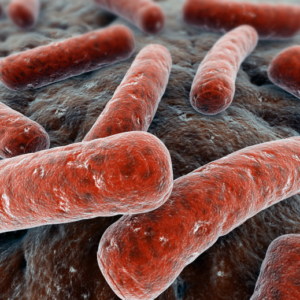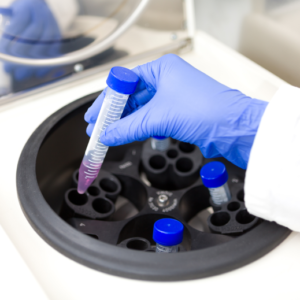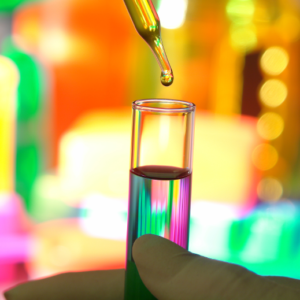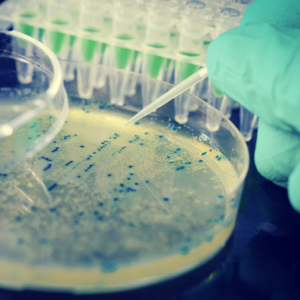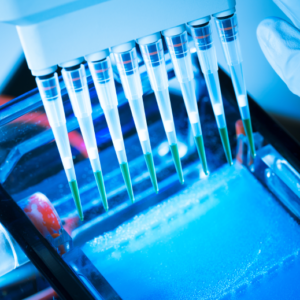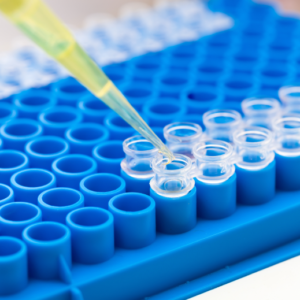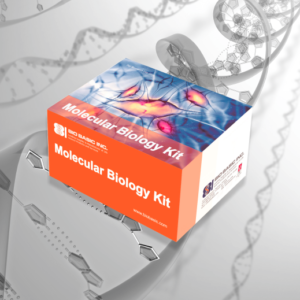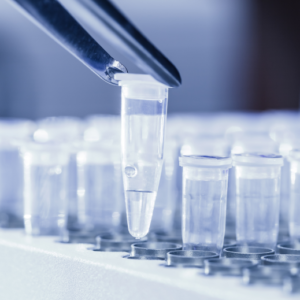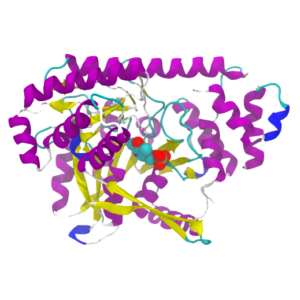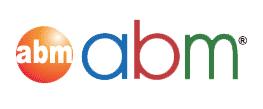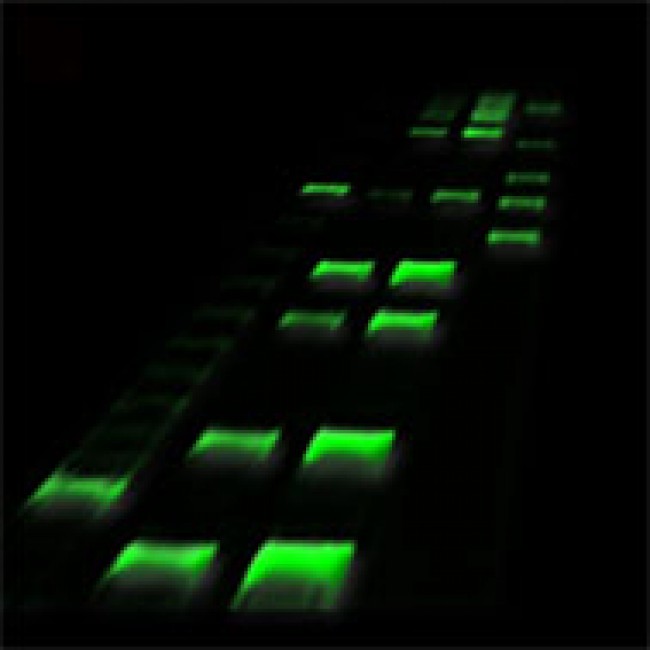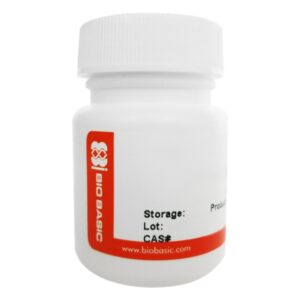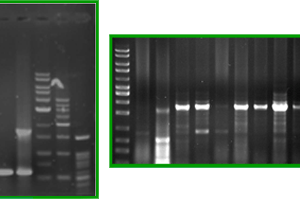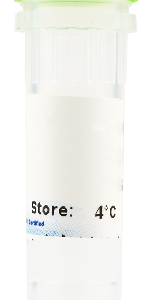Please note, we now offer a new and improved formulation of SafeView (launched Sept 2023). The new formulation comes with several improvements, the most notable of which being that it can now be used for in-gel and post staining. We will however continue to offer the previous formulation until the end of 2024, to aid customers in making a timely transition. This product page is for our previous formulation, which now has the catalogue number NBS-SV1-C
SafeView is a safe nucleic acid stain for the detection of double-stranded DNA, single-stranded DNA and RNA in Agarose gels. This dye replaces Ethidium Bromide (toxic, potential mutagen) commonly used in Agarose gel electrophoresis.
SafeView is as sensitive as Ethidium Bromide and is used in the same way for electrophoresis. SafeView emits green fluorescence when bound to ssDNA, dsDNA and RNA and has a fluorescence excitation maxima at approx 290-320nm, emitting at 515nm.
SafeView is non-carcinogenic and causes significantly fewer mutations in the Ames-test and tests negative in both the mouse marrow chomophilous erythrocyte micronucleus test and mouse spemary spermatocyte chromosomal aberration test. SafeView should be disposed of as any other non-carcinogenic fluorescent dye and in accordance with any existing departmental advise.
Frequently Asked Questions
Can SafeView be a replacement for ethidium bromide? Can I do gel extraction with it?
SafeView can be used as a replacement for ethidium bromide as they both work on general agarose. We recommend using SafeGreen for downstream cloning applications as SafeView can interfere with the ligation reaction, yielding fewer colonies.
How does SafeView work and why is it not carcinogenic?
There are fluorescent compounds in SafeView and these fluorescent compounds have the capability to bind to DNA. There may be some unknown effects of SafeView that have not been documented but that applies to the SYBR set as well; however, SafeView products are definitely not as carcinogenic as ethidium bromide.
How do I use SafeView products?
The SafeGreen and SafeWhite loading dyes work the same as 6x loading dye, loaded with the sample. SafeView is used directly in the gel and the running buffer.
Does the SafeView differentiate double stranded nucleic acid and single stranded nucleic acid? Does the SafeGreen and SafeWhite work the same way?
Under UV, SafeView emits a green fluorescence when bound to both single and double stranded DNA templates, therefore they cannot be differentiated by this method. It will emit a red fluorescence when bound to RNA templates.
The SafeGreen and SafeWhite do not perform in this way and will stain all nucleic acid templates one color.
At what temperature do I store the SafeView products?
All the SafeView products should be stored at four degrees Celsius.
Do I need a special filter for photography of DNA gels stained with SafeView?
Under UV light, SafeView emits a green fluroescence when bound to both single and double stranded DNA templates. It will emit a red fluorescence when bound to RNA templates. No filter is necessary for viewing these colours, however a filter may be needed for photographing the gel.
How long does the SafeView stain last in a gel?
Testing has shown that SafeView stained gels (>10ng DNA loaded per lane) can still be effectively visualised up to 1 week later with only a slight decrease in brightness. Gels should be stored properly to maintain a good signal, at 4C in the dark, sealed in a plastic bag or pouch with wet paper towel loosely wrapped around the gel.
Why is SafeView stain not working on my samples?
Make sure you are following the protocol carefully. It is critical that both buffer and gel have SafeView dye in them otherwise it will not work. This is different from ethidium bromide. You can consider to add 2.5ul of SafeView (instead of 5ul) for every 100ml of running buffer, which will reduce background fluorescence and allow the bands to show with more contrast.
Is it degradable, if so how fast and under what circumstances?
2 hours over 100C
What is the sensitivity of the dyes?
SafeGreen has Excitation Wavelength of 490nm and Emission Wavelength of 525nm, and its sensitivity range is between 0.2-0.6ng.
SafeWhite has Excitation Wavelength of 370nm and Emission Wavelength of 470nm, and its sensitivity range is between 0.2-0.5ng.
SafeView emits green fluorescence when bound to dsDNA and ssDNA and red fluorescence when bound to RNA. This stain has one excitation (490 nm) and two emission spectra (520 nm and 635 nm) and the sensitivity range is between 0.1-0.3ng.
SafeView Plus has Excitation Wavelength of 490nm and Emission Wavelength of 525nm and its sensitivity range is between 0.05-0.1ng.
Can SafeView products be used post-stain?
Only SafeView Plus should be used in a post stain. SafeView and SafeGreen/SafeWhite are not designed for post-staining. SafeView must be added to the gel and the running buffer prior to the loading of the samples. SafeGreen and SafeWhite stains must be added to the sample before loading it to the gel.
Why is the EtBr signal stronger in the pictures when I compare SafeView with EtBr?
A reason for this is that most gel doc systems have been optimized for EtBr so that is why the EtBr signal may be stronger in the pictures.
We see shifting and migration of the DNA fragments. What are the recommendations to minimize this?
Shifting is unavoidable and quite natural for such fragments, regardless of the staining. We suggest using SafeGreen ladders, which will give accurate molecular weight with no additional staining agents needed.
I cannot see 100bp and 200bp bands on a 1% gel. What should I do?
It is very difficult to detect 100bp and 200bp bands in 1% gel with any stains. Higher gel concentrations should be used, such as 2% agarose.
Can I use SafeView products in Polyacrylamide gels?
Yes, we have tested our SafeView products for this application.
Which of the Safe stains will work with blue light / LED?
All of our SafeView stains have been tested in-house to be compatible with UV light. SafeView, SafeView Plus, and SafeGreen will also work under blue light/LED. SafeWhite will only work under UV light.
SafeView Plus should only appear green. SafeView will be red for RNA and green for DNA.
How do I dispose Agarose Gels stained with Safeview and how do I dispose buffers and gloves?
Dispose SafeView as you would any other non-carcinogenic fluorescent dye (eg. Acridine orange; Propidium iodide).
All gels and contaminated “non-sharp” lab debris (e.g., gloves, pads, towels, tubes, etc.) that are processed using this dye can be discarded in the trash.
Spent running buffer solutions and destaining solutions that contain the dyes can either be collected and disposed of through the HWMU or collected and run through an approved filter device.
The buffer solutions that have been run through the approved filter should be checked under the appropriate light source for complete removal of the dyes, and if it passes (does not fluoresce), the liquid can be disposed of down the drain with a copious amount of water as long as no other materials are present that would cause the material to be a Hazardous Waste.
The filters that have been used up and are no longer effective must be disposed of through the HWMU.
Do SafeView products give problems in the process of cloning?
We recommend using SafeGreen for downstream cloning applications, as testing has shown it yields more colonies following the ligation reaction than SafeView.
What device do you use to see the electrophoresis bands?
We use both UV and LED transilluminators, our gel QC pictures in PCR department are taken with UV.
Will staining appear the same when using UV light and LED (same colours)?
UV and LED will give the same colours.
Can this be stored at -20°C?
No, please store at 4°C only. Shelf life of 2 years.
What is the concentration of NBS-SV?
20000X (5ul of the SafeView in 100ml gel solution).
Can SafeView penetrate cell membranes?
Yes, SafeView can penetrate cell membranes.
I used UV light for excitation, and my RNA is not glowing red as would be expected. Any idea why this is happening?
The complex interaction of SafeView with DNA and RNA means that the emission spectrum is affected by secondary structure, temperature, ionic strength, pH and SafeView concentration. Also, at high polynucleotides to SafeView ratios, most nucleic acids will appear green. If the gels contain 6M urea at pH 3.5, all nucleic acids will appear green. So it is not unusual to observe the RNA bands as green under certain conditions.
Can you describe what particular imaging system that one should use to photograph the gel?
Any imaging system with UV and/or LED should work. No filter for Safeview is required, however a filter at ~500-650nm is optional.

